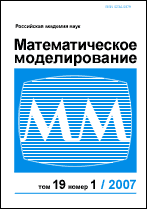|
|
Математическое моделирование, 1996, том 8, номер 9, страницы 129–142
(Mi mm1625)
|
 |
|
 |
Proceedins of the International Conference on the Optimization of the Finite Element Approximations (OFEA-95), St.-Petersburg, 25–29 June 1995
A hybrid coupled finite-boundary element method
G. C. Hsiaoa, E. Schnackb, W. L. Wendlandc
a Department of Mathematical Sciences, University of Delaware, Delaware, USA
b Universität Karlsruhe
c University of Stuttgart, Mathematical Institute A
Аннотация:
In this hybrid method, we consider Trefftz elements where the governing equations of equilibrium
are required to be satisfied a-priori within the subdomain elements of some triangulation of the domain. If the Trefftz elements are modelled with boundary potentials supported by the individual element boundaries, this defines the so-called macro-elements which allow one to handle particular situations involving singular features such as cracks, inclusions, corners, and notches, and which provide locally high resolution of the desired stress field, in combination with a global variational FEM analysis. The bandwidth of the global stiffness matrix is smaller than the one in conventional hybrid FEM methods. In addition, with slight modifications, the macroelements can be incorporated into standard commercial FEM codes. The coupling between the elements is
modelled by using a generalized compatibility condition in a weak sense which allows to relax the continuity requirements for the global displacement field. As a consequence, the mesh points of the macro-elements can be chosen independently of the nodes of the FEM structure. In particular, this formulation provides the possibility of combining independent meshes and also exploiting modern parallel computing facilities. In this lecture we present the formulation, functional analytic setting, asymptotic error estimates and some numerical results.
Образец цитирования:
G. C. Hsiao, E. Schnack, W. L. Wendland, “A hybrid coupled finite-boundary element method”, Матем. моделирование, 8:9 (1996), 129–142
Образцы ссылок на эту страницу:
https://www.mathnet.ru/rus/mm1625 https://www.mathnet.ru/rus/mm/v8/i9/p129
|

| Статистика просмотров: |
| Страница аннотации: | 372 | | PDF полного текста: | 208 | | Первая страница: | 1 |
|




 Обратная связь:
Обратная связь: Пользовательское соглашение
Пользовательское соглашение
 Регистрация посетителей портала
Регистрация посетителей портала Логотипы
Логотипы








 Цитирование в формате
Цитирование в формате 